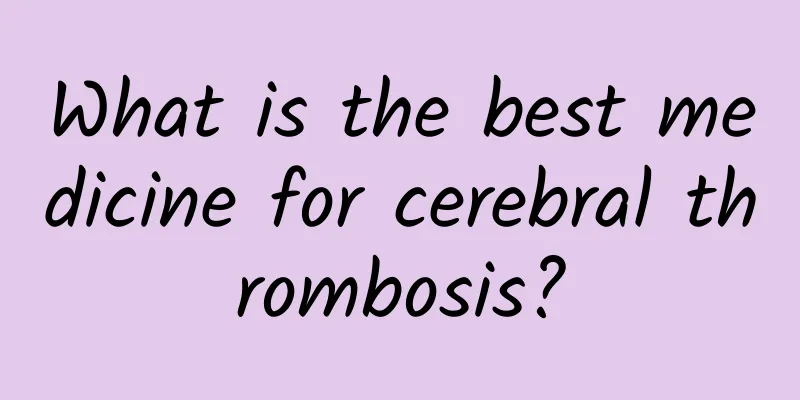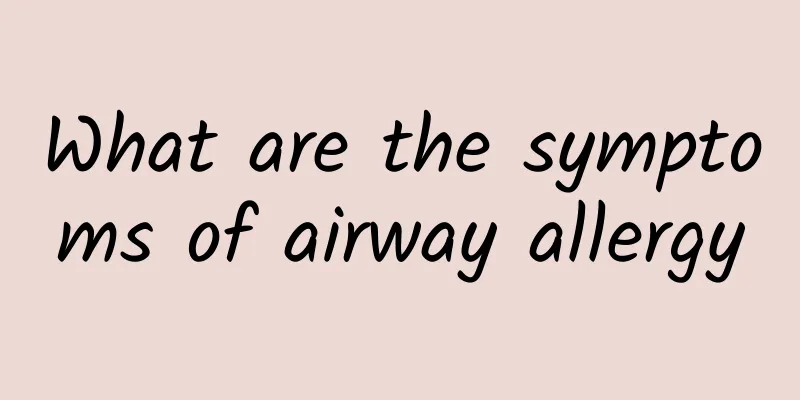What is the best medicine for cerebral thrombosis?

|
Cerebral thrombosis can be said to be a very common disease. It is generally very easy to occur in the elderly. Its symptoms generally manifest as facial paralysis, slurred speech, etc. If such symptoms occur, you must go to the hospital for examination immediately and let the doctor determine whether you have cerebral thrombosis. If you suffer from this disease, you should actively use medication to treat it and control the condition. What is the best medicine for cerebral thrombosis? What is the best medicine for cerebral thrombosis? Tools/Raw Materials What are the clinical symptoms and signs of cerebral thrombosis? If you have cerebral thrombosis, you should seek early treatment. Acute attack Recovery and sequelae Methods/Steps It mainly depends on which blood vessel is blocked. To illustrate this issue, let us first briefly introduce the anatomical knowledge of human cerebral blood vessels. The human brain arteries are divided into two major systems, the internal carotid artery system and the vertebral basilar artery system. The main branches of the internal carotid artery include the middle cerebral artery and the anterior cerebral artery, which supply blood to the anterior 3/5 of the cerebral hemisphere, mainly including most of the lateral surface of the cerebral hemisphere, a small part of the medial surface of the cerebral hemisphere, as well as the basal ganglia and internal capsule. The main branches of the vertebrobasilar artery system include the posterior inferior cerebellar artery, pontine branch and posterior cerebral artery, which supply blood to the posterior 2/5 of the cerebral hemisphere, cerebellum and brainstem. When the blood vessels in the internal carotid artery system are blocked, the main clinical manifestations include weakness, difficulty in movement or complete inability to move on one side of the face and limbs, which is medically known as hemiplegia; numbness of one side of the limbs, known as hemisensory disorder; loss of visual field on one side, known as hemianopsia; some patients may have language disorders, such as being able to understand what others say but being unable to express themselves and having difficulty speaking (motor aphasia); or being able to speak but not understanding what others say (sensory aphasia) or both (mixed aphasia). Depending on the specific location of blood vessel blockage and the size of the infarct, the severity of symptoms may vary. There may be all three hemiplegia and aphasia, or only some of them. There may be severe paralysis of both upper and lower limbs, or only monoplegia of the upper or lower limbs. If the infarction is large, the patient will have severe headache, nausea, vomiting, varying degrees of impaired consciousness, and even coma, and death may occur. When the vertebral basilar artery system is blocked, the main symptoms are sudden dizziness or vertigo, nausea, vomiting, diplopia, tinnitus, slurred speech, difficulty swallowing, unsteady walking, etc. During the examination, nystagmus, unilateral cranial nerve paralysis (such as difficulty in eye movement on one side or facial paralysis on one side), and movement disorders of the contralateral limbs (medically known as crossed paralysis) may be found. If the infarction occurs in the brain stem and the infarction area is large, the patient may quickly develop coma, high fever, pinpoint-sized pupils, quadriplegia or tonic convulsions, respiratory failure and rapid death. What is the best medicine for cerebral thrombosis? Cerebral thrombosis must be treated early, which is related to the patient's life prognosis and subsequent functional recovery. When a blood vessel in the brain is blocked, the blood flow to the brain tissue in the area controlled by the blood vessel is interrupted, and brain cells in the central part where the ischemia is severe will undergo necrosis, which is clinically called an infarction focus. The brain cells in the surrounding area of the infarct are in a state of severe ischemia. Scientific research has confirmed that if the blood flow through every 100 grams of brain tissue is less than 10 milliliters per minute, brain cells will necrotize and infarction will form; while the blood flow in this peripheral zone is less than 15 milliliters per minute per 100 grams of brain tissue. Within this blood supply range, the metabolic function of brain cells is severely damaged, but necrosis will not occur. This area is medically called the penumbra. If the blood supply is improved in time, the brain cells in this area can still recover their functions; if the blood supply is not improved in time, the brain cells in this area will die, the infarction focus will continue to expand, and the patient's clinical symptoms and signs will further deteriorate. The reversible state of the penumbra neurons is short-lived. Animal experiments have confirmed that, generally speaking, the penumbra only exists for a few hours and no more than 24 hours. In humans, the penumbra lasts no longer than 48 hours. Therefore, if we can seize this opportunity and give various active and effective treatments, such as early thrombolytic therapy, early calcium channel blockers and other traditional Chinese medicine treatments to improve cerebral blood flow, we can rescue these reversible nerve cells, limit the development of the infarction focus as much as possible, and preserve the nerve function to the greatest extent. Although treatment at all stages in the course of cerebral thrombosis is very important, early treatment will undoubtedly play a more important role in saving the patient's life and future functional recovery. Moreover, early treatment can timely detect other adverse factors or concomitant diseases that exist at the same time. If the patient experiences increased intracranial pressure during cerebral thrombosis, dehydration treatment to reduce intracranial pressure should be given in time; if the patient has concurrent hypertension, diabetes, heart disease, concurrent infection and various other related diseases, these can all be discovered and treated in time to ensure that the patient receives timely and reasonable treatment and receives good results. Generally, patients can be discharged from the hospital and go home to continue treatment after half a month to a month of hospitalization for an acute attack. The recovery period of cerebral thrombosis is within one year. Even if the effective treatment time window is not seized in the previous acute period, most patients can still receive satisfactory treatment results in the recovery period. The recovery period is crucial for patients with cerebral thrombosis to treat symptoms and prevent recurrence. What is the best medicine for cerebral thrombosis? Recovery and sequelae Secondary research and development of traditional Chinese medicine for the treatment of chronic diseases such as cerebral thrombosis has the advantages of stable efficacy, small side effects, easy absorption, small dosage, and no drug resistance. The application of modern production technology for refined extraction makes the efficacy of traditional Chinese medicine more stable and the dosage form more reasonable. The Compound Danshen Drops and Qingkailing Injection currently on the market are the results of secondary research and development; Tianxintai is a secondary research and development Chinese medicine in the field of cerebral thrombosis treatment. Tianxintai, a Chinese medicine that has been redeveloped, is a large compound that is not prone to drug resistance and can achieve a more ideal effect of increasing efficacy and reducing toxicity. However, large compounds also bring great difficulties to secondary research and development. It took my country 4 years to redevelop the compound Danshen tablets containing 3 kinds of medicinal materials into compound Danshen drops, and it took 8 years to redevelop the large compound Chinese medicine Shengxi Thrombosis Xinmaining Capsules containing 10 medicinal ingredients into Tianxintai Thrombosis Xinmaining Tablets, which is longer than the time used to develop a new drug. Strict clinical trials have been carried out and very ideal clinical results have been achieved, opening up a new path for the secondary research and development of large compound Chinese medicines. It can be said that if patients with cerebral thrombosis choose traditional Chinese medicine, then Tianxintai Thrombosis Xinmaining Tablets is an ideal choice. Not only are the medicinal materials authentic and guaranteed, it also adopts more than ten modern production processes. More importantly, it is a traditional Chinese medicine for cerebral thrombosis that has been successfully developed for the second time. |
>>: Drugs to prevent cerebral thrombosis
Recommend
Can Hepatitis B virus be transmitted to humans?
Hepatitis itself is a serious disease, and hepati...
Will purpura heal on its own without treatment?
Purpura is the name of a disease in Traditional C...
What to do if you have ear inflammation and tinnitus? Traditional Chinese medicine has some tricks for treatment
Do you often feel a buzzing in your ears? This is...
The pros and cons of pit and fissure sealing
The advantage of pit and fissure sealing is to pr...
Can I stop taking medication for depression?
If you have been diagnosed with depression, you m...
What are the effects and functions of the traditional Chinese medicine double flower?
When it comes to double flower, most people may n...
When can autism be detected?
If you want to detect autism, you must judge by s...
How to treat dizziness caused by cervical spondylosis
Cervical spondylosis is a common disease, and the...
What happens if you eat dragon fruit during menstruation?
Dragon fruit is a relatively common fruit with hi...
Is it normal to get acne on your face after taking Chinese medicine?
It is important for girls to have good skin, espe...
Is rubella contagious?
There are many diseases that can be transmitted i...
I got angry during my menstrual period and suddenly stopped menstruating
Normally girls will have their periods every mont...
I always have chest pain before my period.
It is normal for women to experience breast pain ...
Red blood spots on the arms
Everyone's skin properties are different. Some...
Causes of stomach pain under the ribs on the left side
Pain under the ribs on the left side of the stoma...









